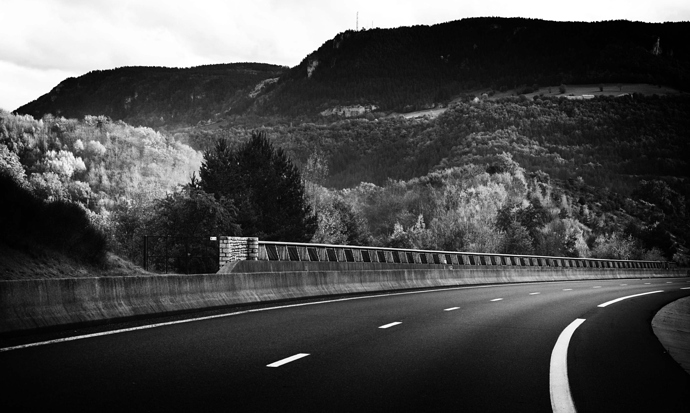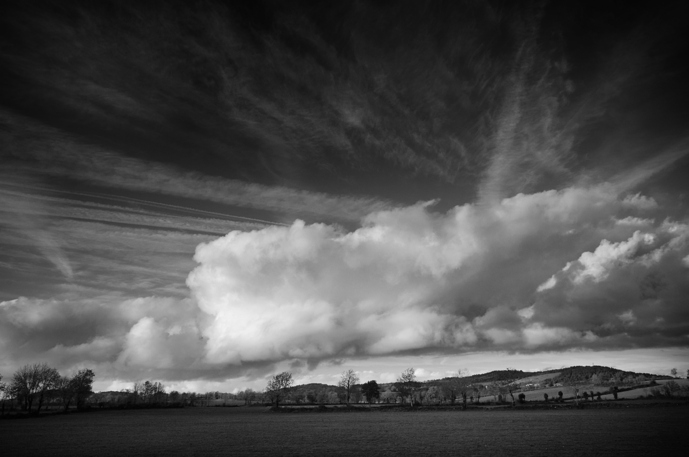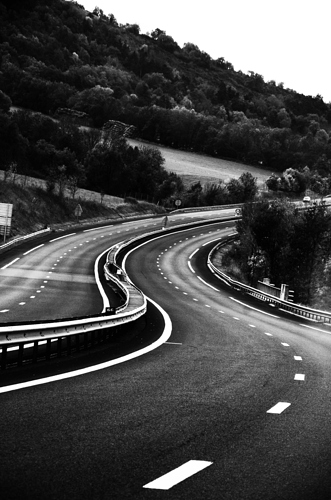November: Heading South
We often find ourselves crossing the Massif Central at thistime of year en route for the gentler climes of the Midi. Probably pure
coincidence, and certainly nothing to do with migration, since we’re committed to
a genuine winter hereabouts, but maybe something to do with the end of autumn
and the last chance to get away before hibernation. Given recent global events,
it seemed particularly appropriate to flee and forget about things for a few
days.
Two years ago, the Good Wife and I set off on the second
part of what seemed like a Jules Verne-style adventure to drive and document La Méridienne: the amazing autoroute that roughly bisects the
Massif on its way south from Clermont Ferrand to Beziers. It crosses some of
the wildest, most dramatic countryside in the land, and, thanks to President
Giscard d’Estaing’s instinct for immortality (and apart from the toll over the
Millau viaduct), you get to see it all for free.
Getting there is the only drag. We followed exactly the same
route as we did two years ago – in roughly the same weather conditions: wild,
windy and wet. Up to Gramat and across the causse
to Figeac, and then down to and alongside the river Lot to the anomalous mining
town of Decazeville, and then on through the Aveyron to Rodez and beyond.
Whereas our custom is to traverse all its roundabouts and
leave Rodez perched on its hill, this time we decided to stop there and visit
the new museum dedicated to one of its few famous offspring: the artist, Pierre
Soulages. If there’s any place in this beautiful part of the world less
welcoming than Rodez, it’s Rodez in the rain. Rather like Tulle, the capital of
the Corrèze, but without its discreet charm, Rodez is heavy, sombre and more
than a little oppressive. Not unlike the canvases of Pierre Soulages, in fact:
an artist now in his 90s, whose palette is mainly black and the sickly brown of
walnut stain.
Actually, we didn’t get to visit the collection until the
return leg. By the time we’d driven round and around trying to find a way into
the tantalising car park, it was 11.30. No, a ticket to the museum would not
entitle us to free parking, and no, the museum would not be open between 12 and
2pm. Screw that for a game of soldiers,
we decided. Good old French public hospitality. So we followed up a look at the
monumental cathedral with an exceptionally good snack lunch in the new Michel
Bras-serie, the famous three-star
Michelin chef who has almost achieved the impossible: by making vegetarian
cuisine respectable in the land of the force-fed goose.
When, finally, two years ago we joined the A75 at
Sévérac-le-Château, the wind was strong enough almost to rip the door from the
car on stopping to visit Les Messieurs
at the service station. This time around the weather wasn’t quite so dramatic,
but still angry enough to transform the sublime scenery of moorland, rocky peaks
and deep river gorges into a lost world, uninhabited save for a few wandering
wild-eyed characters clad in tattered sack cloth.
Nothing, not even a glimpse of the lights at the top of the
nine pillars of Norman Foster’s architectural masterpiece, winking in the
distant gloom from the top of the 900m Col d’Engayresque, prepares you for the
viaduct that bestrides the valley of the Tarn high above the town of Millau.
When first we came this way, one November almost 20 years ago, it was maybe not
even a sketch in an architect’s notepad. We missed the customary bottleneck linking
the two disconnected branches of the motorway, because we hit Millau in the
middle of the night on our return from a trip to Provence to meet a famous
aromatherapist who would, my wife hoped, reveal the mysteries of setting up a
practice in France. She didn’t, and Debs ended up doing it all the hard way.
When I saw it first – three years ago, on coming south for
the 60th birthday of our friend’s late husband, who would die
tragically of premature Alzheimer’s – we got out at the adjacent visitors’
centre to take it all in and shoot countless photos. I’d read all about it –
and heard of its splendour from my wife, who’d been this way solo the year
before that party – but seeing it in the flesh was akin to the thrill I felt of
gazing on the Grand Canyon.
As we drove across the platform – under which, at its
highest point, you could fit the Eiffel Tower – we speculated about the good
citizens of Millau below. Do they, we wondered, wake up each morning and give
thanks to the mighty edifice visible from every street corner? If not, they
should. Not only has it taken away all that traffic, noise and pollution, but
it has also become a landmark that puts an otherwise nondescript town firmly on
the map. Here stands proof that mankind doesn’t have to despoil the natural
world in its relentless drive to modernise.
Depending on the weather, the Causse du Larzac could be either the backdrop for
one of those cheap Republic westerns of the 1950s or, as it was last Thursday,
a kind of windswept lunar landscape fit for neither man nor beast – apart, that
is, from the sheep that roam among the rocks nibbling at the scrub vegetation
that presumably adds the fort to the Roque of the indigenous cheese.
Two years back, we stopped for a look at La Couvertoirade, a
kind of miniaturised Carcassonne, founded and fortified by the Knights Templar.
And just as it did two years ago, on emerging from the tunnel that leads motorists
off the Lazarc plateau and into the Midi, the sun broke through to light up the
vertiginous plunge down through the mountains towards the river valley far
below and thence the Languedocian plain abutting the Med.
It’s a different world down there. Even if we could afford
it, I’m not sure it would suit. There’s the sea of course – if you can ever
penetrate the urban sprawl to get there – and the milder climate. But a denser
population brings heavier traffic. And although here’s little danger of sudden
frosts and no need to bring in the oleanders, a Mistral blew on the Saturday
and the wind-chill factor was significant. I can do without wind in any form.
That evening our friend took us to Avignon for a trip to the
Utopia cinema to see a film called Captain
Fantastic, in which Viggo Mortensen’s character raises his six children in
the dense forest of Washington State. Circumstances inevitably lead to a clash
between his set of values and the ‘normal’ values of an overfed, processed,
de-sensitised and wasteful society. It’s very good: sometimes funny, sometimes
sad and always poignant. And always eerily relevant in the light of current
affairs.
On the return leg, we drove back along the coast towards
Montpelier and some angry black clouds hanging very symbolically above the
overlooking mountains. Sure enough, the weather deteriorated as we emerged at
the top end of the connecting tunnel – and became increasingly spiteful the
nearer we got to home. Across the Larzac plateau, my wife entertained me by
reading excerpts on her phone from The
Guardian’s commentary on the fifth day of a gripping test between England
and India – in which no less than four Anglo-Asian cricketers contrived to
underline the benefits of a multi-cultural society.
But then we graduated from the comfortable world of sport to
a deeply uncomfortable litany of the incoming president’s stated policies:
evict the immigrants, build a wall, frack the land for all it’s worth, wriggle
out of the Paris Treaty, punish women for having abortions… How could a
sentient electorate have voted for someone even less qualified than Ronald
Reagan to run the world’s most powerful country? As if we aren’t in enough of a
mess without creating even more. No wonder I’m pessimistic about mankind’s ability,
for all its technological acumen, to clear it all up. A British architect and a
team of French engineers and navvies can put up one of the greatest bridges
ever conceived, but when it comes to putting our heads together globally to
clean up the oceans or save the African elephant…
It’s what remains of the environment and its wildlife that I fear for the most once
the Trump troll gets to park his big butt behind the desk in the Oval Room. The
idea’s more depressing than Rodez in the rain. My wife turned off her phone and
we soothed our souls with some unchallenging bossa nova. They say (as always) that it’s going to be a hard winter. Leonard Cohen has already succumbed. One thing’s for sure: it’s going
to be a struggle for survival and it won’t be the meek who inherit the earth.
(Black and white photos by my chumly Dan Courtice of Penn Graphics.)


